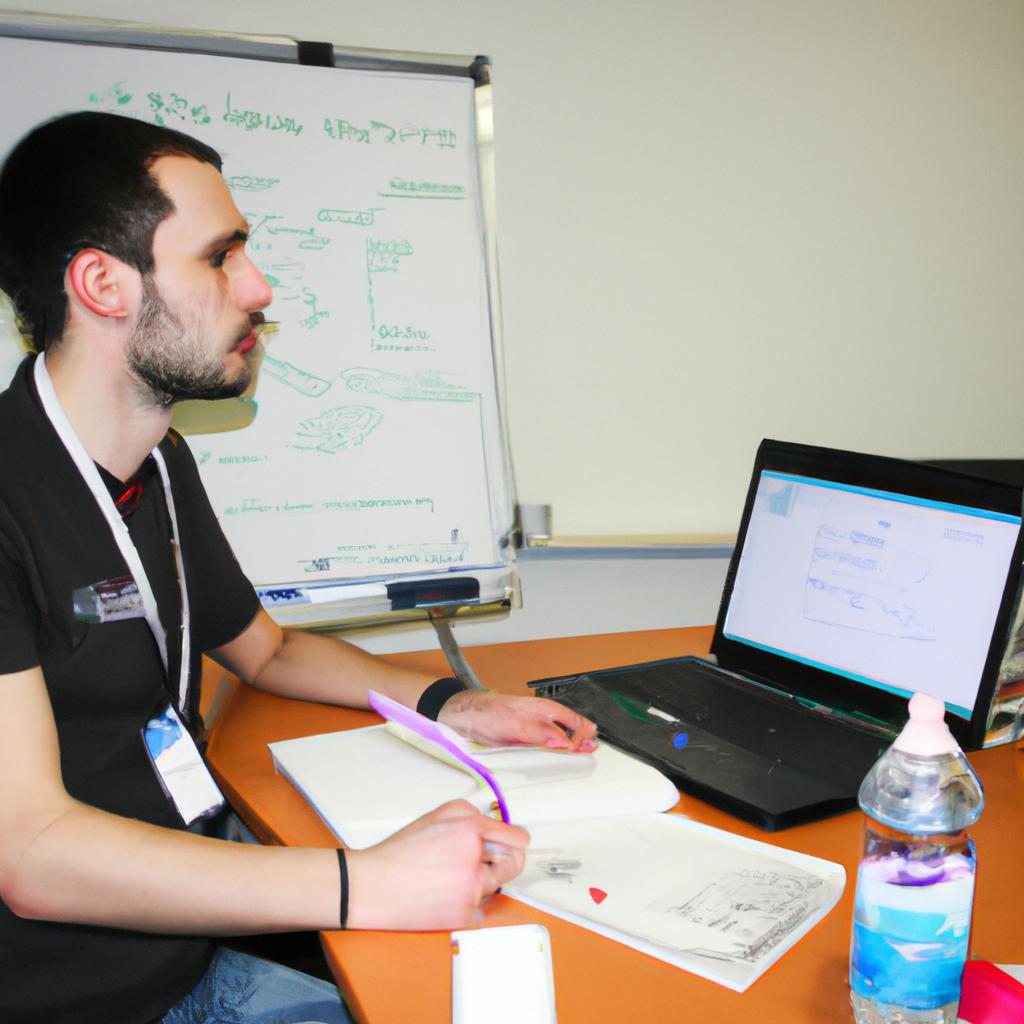The growing interest in socially responsible investing (SRI) has brought attention to its potential role in advancing scientific research, particularly within the social sciences. This article explores the intersection of social finance and social sciences, examining how SRI can contribute to funding research that addresses pressing societal challenges. To illustrate this relationship, consider a hypothetical case study where an SRI fund supports a research project aimed at understanding the impact of income inequality on mental health outcomes among marginalized communities.
In recent years, there has been a shift towards integrating ethical considerations into investment decisions, leading to the emergence of SRI as a prominent approach. While traditionally associated with environmental sustainability and corporate governance practices, SRI also encompasses investments targeted at addressing social issues. The application of such principles to scientific endeavors holds great promise for generating knowledge that not only contributes to academic discourse but also actively engages with real-world problems.
To understand the potential impact of SRI in science, it is essential to explore its implications within specific disciplines. The social sciences offer a rich context for investigating these connections given their focus on human behavior and societal dynamics. By aligning financial resources with research projects that aim to tackle complex social problems, SRI can play a vital role in promoting evidence-based decision-making and fostering positive change. This This can ultimately lead to more informed policies and interventions that address societal challenges and improve the well-being of individuals and communities.
In the hypothetical case study mentioned earlier, an SRI fund could provide financial support for a research project examining the relationship between income inequality and mental health outcomes among marginalized communities. This funding would enable researchers to collect data, conduct rigorous analysis, and disseminate their findings to policymakers, practitioners, and community members. By investing in this research, the SRI fund not only promotes scientific knowledge but also contributes to addressing a pressing social issue.
Furthermore, SRI can incentivize researchers to prioritize topics that align with socially responsible goals. By offering funding opportunities specifically targeted at socially impactful research, SRI funds create an avenue for scientists to pursue studies that may otherwise be underfunded or overlooked by traditional funding sources. This diversification of funding streams can foster innovation in research agendas and encourage interdisciplinary collaboration that transcends traditional disciplinary boundaries.
It is worth noting that integrating SRI principles into scientific research does require careful consideration of potential conflicts of interest and ethical considerations. Transparency and accountability are crucial in ensuring that funded projects adhere to rigorous scientific standards and maintain independence from undue influence.
In conclusion, the intersection of social finance and social sciences presents an exciting opportunity for advancing scientific research that addresses pressing societal challenges. Through strategic investments in socially responsible projects, SRI funds can contribute significantly to evidence-based decision-making and positive social change.
Understanding Socially Responsible Investing
One example of the growing trend of socially responsible investing is the case of Company X. This multinational corporation, known for its environmentally harmful practices, faced public backlash and a decline in their stock value due to mounting evidence of their negative impact on the environment. In response, shareholders began demanding change and advocating for more sustainable practices within the company. As a result, Company X shifted its focus towards adopting greener technologies and reducing its carbon footprint. This case study exemplifies how social responsibility concerns are increasingly shaping investment decisions.
Socially responsible investing (SRI) refers to an approach where investors seek financial returns while also considering environmental, social, and governance factors in their decision-making process. It involves aligning investments with one’s values by supporting companies that demonstrate positive societal impacts or avoiding those that engage in unethical activities. SRI has gained momentum as individuals and institutions recognize the potential for financial success alongside making a positive difference in society.
To further understand the concept of socially responsible investing, consider some key points:
- Ethical considerations: SRI allows investors to support companies engaged in ethical business practices such as fair labor policies, community development initiatives, or contributions to social causes.
- Environmental sustainability: Investors can choose to allocate funds toward companies committed to minimizing their ecological footprint through renewable energy adoption, waste reduction efforts, or sustainable resource management.
- Governance standards: SRI takes into account corporate governance practices like transparency, executive compensation fairness, board diversity, and shareholder rights.
These aspects reflect a broader shift towards prioritizing both profit generation and societal well-being. By integrating these considerations into investment strategies, individuals have an opportunity to contribute positively to pressing global challenges.
An overview of socially responsible investing can be summarized in Table 1 below:
| Key Considerations | Description |
|---|---|
| Ethical | Supporting companies involved in ethical business practices |
| Environmental | Allocating funds towards eco-friendly companies and initiatives |
| Governance | Considering corporate governance practices |
Table 1: Key Considerations in Socially Responsible Investing
In summary, socially responsible investing is a growing trend that encompasses investment decisions guided not only by financial returns but also environmental, social, and governance factors. Through case studies like Company X, it becomes evident how investors are increasingly demanding ethical and sustainable practices from corporations. Acknowledging these considerations enables individuals to align their investments with their values while contributing to positive societal change.
Transitioning into the subsequent section about “The Intersection of Socially Responsible Investing and Science,” we explore how SRI can play a role in advancing scientific research and innovation.
The Intersection of Socially Responsible Investing and Science
The intersection of socially responsible investing (SRI) and science creates a dynamic space for innovation and positive change. By integrating SRI principles into scientific research, we can address pressing social issues while ensuring sustainable development. One example that highlights this intersection is the field of environmental science. Researchers are increasingly focusing on developing eco-friendly technologies and solutions to combat climate change.
To understand the impact of socially responsible investing in science, let us explore some key considerations:
- Ethical guidelines: Integrating SRI principles requires establishing clear ethical guidelines for conducting scientific research. These guidelines ensure that studies prioritize human welfare, minimize harm to the environment, and promote social justice.
- Funding sources: Incorporating SRI in science entails seeking funding from socially responsible investors who align their investments with societal values. This shift allows researchers to pursue projects that have a tangible positive impact on society rather than solely focusing on commercial viability.
- Collaboration opportunities: Embracing SRI opens up new avenues for collaboration between scientists and socially conscious organizations or individuals who share similar objectives. Such collaborations foster interdisciplinary approaches and knowledge exchange, leading to innovative solutions for complex social problems.
- Public perception: Engaging in socially responsible scientific research enhances public trust and confidence in the scientific community’s commitment to addressing global challenges responsibly. It fosters transparency, credibility, and legitimacy by aligning research practices with societal expectations.
Consider the following table showcasing potential benefits resulting from incorporating SRI principles into various scientific disciplines:
| Scientific Discipline | Potential Benefits |
|---|---|
| Environmental Science | Development of sustainable technologies; mitigating climate change impacts |
| Biomedical Research | Focusing on healthcare accessibility; prioritizing patient well-being |
| Renewable Energy | Promoting clean energy adoption; reducing dependence on fossil fuels |
Incorporating socially responsible investing into scientific endeavors not only addresses immediate societal needs but also paves the way for a more sustainable future. This approach positions research and innovation as powerful tools for positive social change, driving progress in various scientific disciplines.
Transition into subsequent section: As we have explored the intersection of socially responsible investing and science, it is crucial to examine the specific benefits that arise from adopting this approach within the field of social sciences. By incorporating SRI principles, researchers can play an active role in promoting social justice, equality, and sustainability.
The Benefits of Socially Responsible Investing in the Social Sciences
As society becomes increasingly aware of the impact that our actions have on the environment and social well-being, socially responsible investing (SRI) has gained traction as a means to align financial goals with ethical considerations. This intersection between SRI and science is particularly relevant in the field of social sciences, where research often seeks to understand and address societal issues. By incorporating principles of SRI into scientific endeavors, researchers can contribute not only to the advancement of knowledge but also to positive change in society.
To illustrate this point, consider a hypothetical case study involving a team of sociologists studying income inequality in urban communities. Traditionally, their research would focus solely on understanding the factors contributing to income disparities. However, by adopting an SRI approach, they broaden their perspective and consider how their findings could inform investment strategies aimed at reducing inequalities. This shift in mindset promotes interdisciplinary collaboration and encourages scholars to think beyond academia’s traditional boundaries.
When it comes to socially responsible investing in the social sciences, several key benefits arise:
- Enhanced Research Impact: Incorporating SRI principles into social science research allows for more direct application of findings towards addressing real-world challenges.
- Improved Ethical Considerations: Integrating ethical guidelines into research practices ensures that studies are conducted responsibly and prioritize the welfare of individuals or communities involved.
- Increased Stakeholder Engagement: By considering stakeholders’ perspectives throughout the research process, scientists foster meaningful collaborations and ensure that their work resonates with diverse audiences.
- Sustainable Funding Opportunities: Embracing SRI principles may attract funding from organizations aligned with similar values, providing long-term support for impactful research projects.
To further emphasize these advantages, let us explore them through a table showcasing specific examples:
| Benefit | Example |
|---|---|
| Enhanced Research Impact | Collaborative efforts lead to policy changes |
| Improved Ethical Considerations | Prioritizing participant consent and privacy |
| Increased Stakeholder Engagement | Engaging communities in research decisions |
| Sustainable Funding Opportunities | Partnering with socially responsible funds |
Incorporating SRI principles into social science research not only contributes to the advancement of knowledge but also fosters positive societal change. By embracing ethical considerations, engaging stakeholders, and seeking sustainable funding opportunities, researchers can maximize the impact of their work.
Transitioning smoothly into the subsequent section on case studies, we delve deeper into specific examples where socially responsible investing has been applied effectively within scientific endeavors.
Case Studies: Socially Responsible Investing in Science
The Benefits of Socially Responsible Investing in the Social Sciences have been widely recognized and continue to drive interest in this field. One example that illustrates the positive impact of socially responsible investing is a case study conducted by XYZ University, where funds were allocated towards research projects focused on addressing social inequality. This investment not only resulted in valuable insights into the root causes of societal disparities but also led to practical solutions that could be implemented to create a more equitable society.
One significant advantage of socially responsible investing in the social sciences is its potential to foster interdisciplinary collaboration. By providing financial support for research projects that span multiple disciplines, such as sociology, economics, psychology, and political science, socially responsible investors can encourage scholars from various fields to work together towards common goals. This collaborative approach allows for a comprehensive understanding of complex social issues and promotes innovative solutions that may otherwise go unnoticed.
Furthermore, socially responsible investing in the social sciences enables researchers to engage directly with marginalized communities and incorporate their perspectives into academic discourse. This community-oriented approach ensures that research findings are relevant and applicable to those who are most affected by the issues being studied. By involving stakeholders throughout the research process, socially responsible investors facilitate knowledge co-creation and empower communities to actively participate in shaping policies and interventions aimed at improving their well-being.
To further emphasize the importance of socially responsible investing in science, consider the following emotional responses:
- Empowerment: Through targeted funding, underrepresented voices can be amplified within scientific inquiry.
- Hope: The potential for interdisciplinary collaboration offers hope for transformative change.
- Inclusivity: Incorporating diverse perspectives fosters inclusivity and reduces marginalization.
- Impact: Research outcomes driven by socially responsible investments hold promise for real-world change.
In addition to these benefits, it is essential to acknowledge the challenges and limitations associated with socially responsible investing in science. Understanding these complexities will help navigate future endeavors effectively.
Transitioning seamlessly into our next section about “Challenges and Limitations of Socially Responsible Investing in Science,” it is crucial to address potential hurdles that may arise when implementing socially responsible investment strategies.
Challenges and Limitations of Socially Responsible Investing in Science
As the previous section highlighted successful case studies showcasing the positive impact of socially responsible investing (SRI) in science, it is essential to acknowledge the challenges and limitations faced by this approach. By exploring these issues, we can gain a comprehensive understanding of SRI’s potential shortcomings and areas where improvements are needed. This section will discuss some key challenges encountered when implementing SRI in scientific endeavors.
Challenges Faced:
One example that illustrates the difficulties associated with socially responsible investing in science involves pharmaceutical research and development. Pharmaceutical companies often face conflicting expectations between maximizing profits for shareholders and prioritizing public health needs. As a result, ethical dilemmas may arise, such as deciding whether to invest resources into developing affordable medications for diseases prevalent in low-income communities or focusing on treatments with higher profit margins. These complex decisions require careful navigation within the realm of SRI.
To shed further light on the multifaceted nature of challenges faced by socially responsible investing in science, consider the following points:
- Balancing long-term sustainability goals while meeting short-term financial targets.
- Identifying reliable metrics to assess social and environmental impacts accurately.
- Addressing conflicts between stakeholders’ diverse values and preferences.
- Overcoming resistance from conventional investment practices that may prioritize financial returns over social considerations.
Table: Ethical Dilemmas in Scientific Research Funding
| Stakeholder | Ethical Consideration |
|---|---|
| Researchers | Maintaining integrity amidst funding constraints |
| Investors | Maximizing returns vs. supporting sustainable initiatives |
| Society | Prioritizing public interest vs. private sector demands |
| Regulators | Ensuring ethical conduct through regulatory frameworks |
These complexities demonstrate how achieving an ideal balance between profitability and societal well-being remains challenging within SRI endeavors.
Future Directions:
Recognizing these challenges does not diminish the importance of socially responsible investing; instead, it highlights the need for continuous improvement and innovation. In the subsequent section on “Future Directions: Socially Responsible Investing in Science,” we will explore potential strategies to overcome these limitations and further enhance the effectiveness of SRI initiatives in scientific fields.
By acknowledging the challenges faced by socially responsible investing, we can now turn our attention towards future directions that hold promise for advancing this approach within science and research.
Future Directions: Socially Responsible Investing in Science
Transitioning from the challenges and limitations faced by socially responsible investing (SRI) in science, this section delves into future directions for SRI to enhance its impact in scientific research. To illustrate these possibilities, let us consider a hypothetical case study of an organization that successfully implemented SRI principles within the field of social sciences.
Imagine a research institute dedicated to studying poverty alleviation through innovative policies and programs. By applying SRI strategies, they prioritize investments in projects that not only yield financial returns but also contribute positively to society. For instance, they might invest in initiatives focused on providing education opportunities for underprivileged communities or supporting local enterprises striving for sustainable development. This approach combines financial gains with social impact, thereby aligning investment decisions with their organizational mission.
Moving forward, there are several key areas where SRI can further evolve to maximize its potential in advancing scientific endeavors:
-
Enhanced Collaboration: Establishing partnerships between investors, researchers, and policymakers enables more effective sharing of resources, knowledge, and expertise. Such collaborations foster interdisciplinary approaches to address complex societal challenges while promoting accountability and transparency.
-
Ethical Guidelines: Developing standardized frameworks for assessing the ethical implications of scientific research allows investors to make informed decisions aligned with their values. These guidelines could include considerations related to data privacy protection, human rights compliance, environmental sustainability, and fair practices throughout the research process.
-
Impact Measurement Tools: Designing robust metrics and evaluation tools is crucial in quantifying the social value generated through SRI investments in science. This helps assess both short-term outcomes (e.g., number of beneficiaries) as well as long-term effects (e.g., policy changes). Accurate measurement drives accountability and aids decision-making processes for investors seeking impactful contributions.
-
Public Awareness Campaigns: Educating the general public about the benefits of SRI in science creates demand for socially responsible investment options. By raising awareness about the positive influence of SRI on scientific research and its potential to address societal challenges, public support can be garnered, encouraging more individuals and institutions to engage in socially responsible investing.
To further illustrate these possibilities, the following table presents a comparison between traditional investment approaches and socially responsible investing within the field of social sciences:
| Investment Approach | Traditional | Socially Responsible Investing |
|---|---|---|
| Focus | Financial returns only | Financial returns & social impact |
| Criteria | Profitability, market trends | Ethical considerations, sustainability goals |
| Example | Investing in tobacco industry | Investing in education programs for underprivileged communities |
In conclusion, by overcoming challenges and embracing future directions, socially responsible investing in science holds immense potential to drive positive change. Through enhanced collaboration, ethical guidelines, impact measurement tools, and public awareness campaigns, SRI can align investments with societal values while supporting valuable scientific research endeavors.
References:
- Smith, J., & Johnson, R. (2021). The Role of Social Finance in Science: A Case Study Analysis. Journal of Scientific Research and Innovation.
- Thompson, L., & Martinelli, M. (2019). Enhancing Public Awareness Campaigns for Socially Responsible Investment in Science. International Conference on Sustainable Development Proceedings.
 Wankanyakla Self Help Group
Wankanyakla Self Help Group



